
|
Mother Pelican
Meditations on Man and Woman, Humanity and Nature
|
|

|
|
|
|
Meditation Seeking Understanding ~ Sacraments
These pages are meditations on the mysteries of the creation, the incarnation, and the redemption. They explore the Christian understanding that all men and women are consubstantial in one and the same human nature, and are consubstantial with Jesus Christ as to his humanity. The meditations are based on a layman's reading of the Sacred Bible, the Catechism of the Catholic Church, and the Theology of the Body as they pertain to the egalitarian complementarity of man and woman, which transcends the patriarchal binary of mutually exclusive male-female opposites. This understanding of the complementary equality of man and woman applies to all the sacraments, sheds light on the great nuptial mystery of Christ and the Church, and would seem to support the ordination of women to the ministerial priesthood and the episcopate.
|
Sacramental Unity of Man and Woman
Working Draft - 15 February 2016
PRAELUDIUM
|
In the Catholic Church, the resistance to the ordination of women is rooted in a sacramental theology that conflates the patriarchal gender binary with biblical revelation. This is a meditation on human nature, male and female, as it pertains to the sacramental priesthood of the New Law when unconstrained by the patriarchal priesthood of the Old Law. This is a visceral issue that cannot not be settled by reasoning alone. This page attempts to support prayerful discernment by stepping outside of the patriarchal box and reconsidering the issue in light of the deposit of faith and the signs of the times.
On the gift of love and the gift of life:
"Like a bridegroom Christ went forth from his chamber, he went out with a presage of his nuptials into the field of the world... He came to the marriage bed of the cross, and there, in mounting it, he consummated his marriage. And when he perceived the sighs of the creature, he lovingly gave himself up to the torment in place of his bride, and he joined himself to the woman for ever."
St. Augustine (354-430)
"Blessed are those who are invited to the marriage supper of the Lamb."
Revelation 19:9
What matters is unity of hearts in one flesh, male and female!
Acronyms and Links:
|
ORIGINAL UNITY OF MAN AND WOMAN

Creation of the First Human Person and Subsequent Sexual Differentiation
Genesis 1:26-27; 2:7, 23; 3:16; 5:1-2; CCC 371, 372, 383; TOB 2:4, 3:2, 4:2, 8:1, 8:4, 9:2
Image: Cappella Palatina, Palermo, Italy
Every human being is a unity of body and soul (corpore et anima unus). Human bodies are normally male or female, but personal subjects are male and female. All human beings, male and female, share one and the same human nature, body and soul.
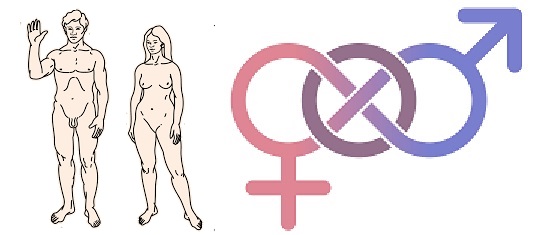
Male and Female, Unity in Diversity, in the Image of God ~ Hebrews 2:14-17, TOB 8:1-4
TERMINOLOGY: Sex is objective (physical, biological). Gender is subjective (psychological, neurological). To be male or female refers to the body. To be masculine or feminine refers to both sex and gender, and is influenced by culture. The human being is a body, but the personal subject is more than just a body (mind, heart, soul, spirit).
Bodiliness and sexuality are not identical realities; being a body precedes being male or female. The body is a sacrament of the entire person, but is not the entire person.
QUESTIONS: The body is normally male or female, but what about persons who are born with intersex bodies? The personal subject is always male and male (mostly masculine or feminine), but what about gender? Is it binary? Else, what are the implications for family life, human relations, ministerial vocation? What are the repercussions for the sacramental life and apostolic mission of the Church?
Each human person is unique and unrepeatable, but all humans are made of the same dust, of the same flesh, whether their bodies are male or female. All men and women are consubstantial, of the same human nature, in a unity of body and soul that is unique for each person yet identical for all persons; male and female God created them, as an image of the three divine persons of the Trinity who different but of the same divine nature.
We are made in the image of God, not the other way around. Do we really believe that "God the Father" is exclusively masculine? Was the "Son of God" exclusively masculine before the incarnation? All three persons of the Trinity are Love: masculine and feminine, initiative and receptive ("1 God, 2 processions, 3 Persons, 4 relations"). For this very reason, it is in the interpersonal communion of man and woman that the image of God becomes more fully visible.
The sex/gender binary is a simplistic artifact rooted in the patriarchal culture, not divine revelation. The natural unity of man and woman was corrupted but not destroyed by original sin. All men and women are still consubstantial, of the same nature, of the same matter, of the same flesh. It follows that, for the redemption and the sacramental economy, the incarnated masculinity of Jesus is as incidental as the color of his eyes!
|
INCARNATION
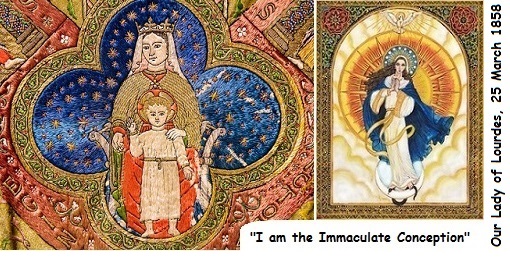
Mary, the New Eve, Mother of God, Mother of Christ-Church, Mother of Humanity
Genesis 1:26-27; 2:7, 23; 3:16; 5:1-2; Luke 1:38; John 1:14, 6:55-56; Galatians 4:4; Ephesians 5:27; CCC 773, 973, 1076; TOB 21:5-6; 97:2, 102:4
Image: Mary, Mother of God - Aleteia (Fr-Lawrence-Lew-OP-CC)
Image: The Immaculate Conception - Theophilia
"I am the Immaculate Conception." What does that mean? Was the immaculate conception a unique event in human history? Sure, but it is much more. "I am the Immaculate Conception." Mary is the Immaculate Conception, a human being, the new Eve, a human person who is also the Mother of God, now assumed body and soul to heaven but of the same nature, of the same flesh as every other human being; and, of the same flesh as her Son, Jesus Christ our Lord.
If a female human person can be the Immaculate Conception, and the Mother of God, before Pentecost and the sacramental economy, why is it that a female human person cannot be an ordained priest in the sacramental economy?
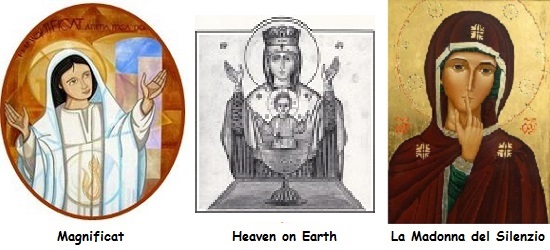
Sacramental unity is not only about ontological realities. Unity becomes real in action. After the Annunciation, Mary went to serve Elizabeth and proclaim the Magnificat. After the Nativity, she went with Joseph and the Baby to Egypt, came back, took care of him as he was growing up. During his public ministry, she followed him around, telling his disciples to obey him ("Do whatever he tells you") but otherwise kept mostly silent. When should we keep silent, and when should we express our concerns about the Church?
Should we assume that uncritical deference to authority is always for the glory of God and the good of souls?
Jesus is the "Son of Man," but was the divine "Son of God" a male before the incarnation? That the second person of the Trinity assumed human nature and became flesh is a certainty of faith; but beyond this, for the redemption and the sacramental economy, is the masculinity of Jesus more important than the color of his eyes? His flesh is our food, the "bread of life." Is bread masculine? His blood is our drink. Is blood masculine?
God assumed human nature when Mary accepted her unique vocation to be the mother of Jesus. In Mary, the Eternal Word became flesh, as flesh of her flesh. Thus Mary preceded the entire sacramental economy. She who had never been baptized, by her fiat became the Mother of God. In Mary, the Old Law was fulfilled by being turned upside down and inside out. In her womb, the omnipotent God became the most vulnerable Servant of the New Law.
The Holy Family was not a patriarchy, thus revealing that the Holy Trinity is not a patriarchy. Jesus would never identified himself as a patriarch, thus revealing that his spousal love for the Church is not essentially patriarchal. Jesus Christ is head of the Church because he is a divine Person and our Redeemer in the flesh, not because he is a human male. Mary is the type of the Church, the type of humanity; she is the sinless bride that preceded sinful humanity, and a Church of baptized sinners, in the nuptial communion of the sacramental economy.
The eternal Word, "eternally begotten," became flesh, in a human body, by an act of God, not by an act of man, even though Mary was the consenting "handmaid of the Lord." It was no accident that he was born a male under the Old Law, in a patriarchal society, for God comes to us where we are; but for this reason, his masculinity is utterly incidental for the redemption and the sacramental economy.
|
REDEMPTION

The Redemption of the Body and Humanity, Male and Female
Genesis 3:16; Mark 16:2-3; Matthew 23:37; Luke 2:52, 13:34; John 4:27-30, 16:12-13, 20:1-2; Galatians 3:28; CCC 26ff, 1066ff, 1691ff; TOB 31:2
Image: Hen Gathering Chicks Under Her Wings - Edge of the Enclosure
Since 4000 BC or so, when patriarchy became to prevailing mode of human relations and family structure, human development has been conditioned by male domination and female subordination.
N.B. The Bible was written starting 1000 BC or so, long after patriarchy had become the normal (but not natural) order of things.
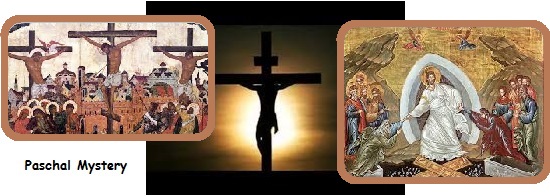
All the mysteries of the life of Christ, from the Annunciation to the Ascension, are made visible in the flesh of a concrete human being, Jesus of Nazareth, who lived in one place, at one time, in one family, in one culture. He grew up as the son of his parents, worked for a living, went around doing good and planting the seeds of the God's kingdom as best he could, challenged his culture without imposing anything that people could not understand, had male and female friends who became disciples, had male and female detractors, and died as a servant king but rose as the Servant King. He chose celibacy for the sake of the kingdom and by choice never became a father, but would not have been able to be a mother; for sexual differentiation is a gift but also a limitation of the human condition. Jesus was God in time and space, yet like us in all things but sin.
The first millennium of the Christian era was spent defining the Creed and the "one person, two natures" Christological dogmas. The second millennium was spent defining the sacraments and the Marian dogmas that prefigure the Church. Perhaps the third millennium will be about understanding the great nuptial mystery of Christ and the Church, and further embracing the tripod of redemptive fruits he gained for us: the transition from the Old Law to the New Law, the emancipation from all forms of slavery, and the restoration of male-female communion. But the patriarchal binary is the stone that still blocks the entrance to the tomb, and this imbalance of male domination and female submission must be corrected during the "already, but not yet" time window of the pilgrim Church that goes from Pentecost to his second coming in glory.
Before the redemption, under the patriarchal Old Law of Moses, integral human development was constrained by patriarchal (and unnatural) rivalry between man and woman. After the redemption, under the New Law of Christ, integral human development can flourish in the restored unity of man and woman. But there is no such thing as integral human development in Christ that is exclusively male or exclusively female. In our "already/not yet," it is time to give top priority to the third leg of the Pauline tripod!
After the redemption, under the New Law of Christ, the original unity of man and women is sacramentally restored by the redemption of the body, male and female. This sacramental unity of all the baptized, male and female, cancels the simplistic patriarchal "binary" that prevailed under the Old Law of Moses. "There is neither Jew nor Gentile, neither slave nor free, nor is there male and female, for you are all one in Christ Jesus."
It follows that article 1024 of the current Code of Canon Law ("a baptized male alone receives sacred ordination validly") is understandable as a legacy of the Old Law of Moses but makes no sense in the sacramental economy under the New Law of Christ.
|
NUPTIAL COVENANT
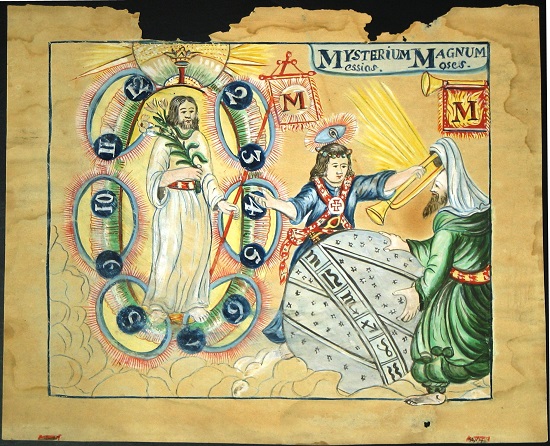
Mysterium Magnum: From the Law of Moses to the Law of Christ
The Nuptial Covenant ~ Analogy of the Bridegroom and the Bride
Genesis 2:24; Exodus 31:18, 33:11; Isaiah 54:5; Jeremiah 31:31-33; Matthew 16:19, 18:18, 19:4-5; Acts 15:28; Ephesians 5:21-33; Hebrews 9:15; CCC 796, 802-810, 1616; TOB 1:3, 2:1, 8:1, 19:5, 33:3, 87:2-3, 91:1, 93:6, 97:2, 99:2, 102:1
Image: Image: F&M Pennsylvania German Fraktur Collection
Image: Biblical Hebrew Studies
Yahweh called Moses his "bride" ("kalah" in Hebrew). But was Moses a woman? The word "kalah" means completion or perfection. Does it mean that Moses "completed" or "perfected" God? Yahweh also called Israel his chosen people, his "bride," his "kalah." Does it mean that Israel was just a woman, or a people, who "completed" or "perfected" God?
"Analogy — as is well known — indicates at one and the same time similarity and also lack of identity (that is, substantial dissimilarity)" TOB 33:3. In the TOB, the word "analogy" appears 139 times, and it is repeatedly made clear that an analogy is not to be understood as identical to the reality it describes. An analogy is just a metaphor of a reality.
It is unreasonable and unbiblical (and a common literalist error) to read the beautiful analogy as Christ as Bridegroom, and the Church as Bride, via a patriarchally biased lens. The Church is a communion of persons, not an individual woman. The Church is the mystical body of Christ, but is the Church divine? Not even the Virgin Mary is divine!
Likewise, is it reasonable to infer that Jesus' pre-Easter choice of the 12 male apostles was intended to be normative after the resurrection and Pentecost, and until his return in glory at the end of time? Would Jesus, in today's Church, choose 12 males to represent the patriarchs of the 12 tribes of Israel?
When Jesus gave the power of the keys to Peter, he was submitting to the will of the Church on earth. This is a great mystery (mysterium magnum) and may be the most beautiful and most misunderstood mystery of the Christian faith. He who is Priest, Prophet, and King, as well as Victim, voluntarily entrusted the continuation of his mission to the Church and gave her the power, wisdom, and authority to sacramentally bring the Good News to all nations.
The old nuptial covenant between God and Israel now becomes a new covenant between Christ and the Church, who becomes one flesh with Christ and the great sacrament (sacramentum magnum) of divine mercy in this world. It is a nuptial mystery that encapsulates the primordial sacrament of male-female unity in one flesh but also reveals that there is a Christ-Church unity that points to a God-Human unity (theosis) as the ultimate goal of evangelization until the Lord returns in glory.
The spousal meaning of the body, both the human body and the Church as the body of Christ, is by no means limited to a superficial patriarchal interpretation of the bridegroom-bride analogy. The spousal bond of Christ-Head and Church-Body radically transcends the patriarchal binary of male domination and female subordination. Jesus Christ is head of the Church because he is a divine Person and our Redeemer in the flesh, not because he is a human male. This nuptial meaning of the Christ-Church mystery as a communion of persons, in the image of the Trinity, applies to all the sacraments.
The human body is normally male or female, but humanity is male and female. The eternal Word was not a male before the incarnation. After the redemption, there is a radically new covenant between God and humanity, signified by the nuptial Christ-Church covenant, the mystery of the Church as the body of Christ. But, if Christ's body includes the entire people of God, male and female, why should the headship of the pilgtim Church be exclusively male?
|
SACRAMENTAL UNITY OF MAN AND WOMAN
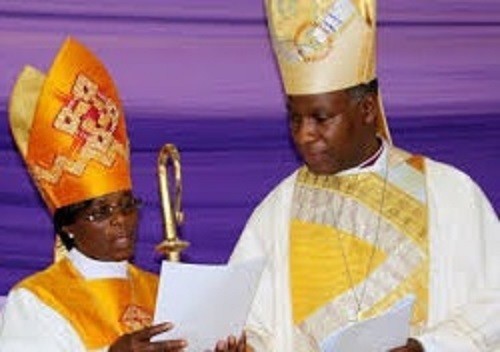
Christ-Church, a Communion of Persons, Male and Female:
Head and Body, Father and Mother, Son and Daughter, Brother and Sister
Psalm 8:4–6; Matthew 16:19, 18:18; John 1:1-14, 6:48-58, 16:12-13; Acts 15:28; Galatians 3:28; Philippians 2:7-8; Colossians 1:15-20; Hebrews 10:10; Acts 15:28; CCC 239, 242, 248, 262, 370, 467, 685, 703, 1577, 1598, 2789; TOB 1:3, 2:4, 3:2, 4:2, 8:1-4, 13:1, 19:2-5, 21:6, 25:2, 31:3, 33:2-4, 35:5, 41:1, 58:2, 59:4, 65:3, 66:2-4, 67:3, 69:4-8, 70:5-7, 75:3, 76:5-6, 78:5, 79:9, 80:1, 81:4, 86:4, 87:5, 89:3-8, 90:1-6, 91:3, 92:6, 93:5-6, 94:5, 95:2, 95b:1, 96:5,7; 97:5, 99:2, 102:4-7, 104:4-5, 114:8, 115:6, 116:5, 117:5, 117b:2, 6, 121:1-3, 122:1-2, 123:7, 124:1, 126:2, 129:2-5, 130:5, 133:3
Image: Swaziland Gets Africa's First Female Bishop, Ellinah Wamukoya - News Bytes Now
Points to be considered:
HEAD & BODY ~ The sacramental economy radically transcends the patriarchal differentiation of man and woman. The eternal Word was not a male before the incarnation. His maleness is part of God assuming all the limitations of embodied humanity (the human body is either male or female), and consistent with the divine pedagogy of coming to use where we are; if incarnated as a woman, Jesus could not have been a rabbi without hosts of angels opening the doors of the synagogue for him). All human beings, male and female, are homogeneous in their "whole being."
Our Lord Jesus Christ is the head of the Church because he is a divine Person and our Redeemer in the flesh, not because he is a human male. The head of the human body is of the same flesh, somatically homogeneous with other parts of the body. Any baptized person, male or female, is an "icon of Christ" and can be ordained to act in persona Christi capitis.
UNITY IN DIVERSITY ~ There is no such thing as two human natures, one that is male and one that is female. All humans, and therefore all the baptized, are somatically homogeneous and consubstantial in their whole being, their redeemed bodies being of the same flesh and making visible their souls as images of God; and their essential unity in one and the same human nature, and full equality in personhood, subsists intact regardless of sexual differentiation or any other pyschosomatic differences.
The patriarchal binary is a cultural artifice concocted after original sin; it is not natural law, let alone divine law.
BODY SACRAMENTALITY ~ For the redemption, what matters is that God assumed a human body ("This is my body"). Sexual differentiation is a gift but is also a limitation of the human condition. Jesus is "like us in all things but sin". For the sacramental economy, the masculinity of Jesus is as incidental as the color of his eyes. This applies to all the sacraments, including the ministerial priesthood. The exclusively male priesthood is patriarchal heritage received from the Old Law that has yet to be discarded under the New Law.
N.B. It is significant that Jesus never identified himself as a patriarch. He identified himself as a human being ("son of man") and explicitly declared the sacramentality of his body and blood without any limitation to masculinity or any other psychosomatic trait of his concrete historical incarnation:
"This is my body ... This is my blood ..."
"I am the living bread ... This bread is my flesh ..."
"Whoever eats my flesh and drinks my blood ..."
FLESH, BLOOD... HUMAN FLESH, HUMAN BLOOD... in the words of Christ, there is no trace of testicular sacramental theology. During his public ministry, he was under the patriarchal prohibitions of the Old Law, but it is clear he never intended such prohibitions to be enforced under the New Law after his death and resurrection, and gave the Church the power of the keys to lift them in due time. Just as male circumcision is not a prerequisite for baptism, male genitalia is not a prerequisite for ordination to the ministerial priesthood of the New Law.
HUMAN LANGUAGE ~ Hebrew is a language that has no neuter gender, everything is binary, male *or* female, but we know that "God is Love." "God the Father" is not exclusively male. "God the Son" was the Eternal Word before the incarnation, and not exclusively male. "God the Holy Spirit" is not exclusively male. The Trinity is a communion of divine persons, not a patriarchy. The Holy Family was not a patriarchy. Jesus never identified himself as a patriarch.
The Church is "one, holy, catholic, and apostolic," but is not essentially patriarchal. Families are evolving from sole male headship to joint male-female (father-mother) headship. This is an undeniable sign of the times. The patriarchal language that obscures biblical texts and magisterial teachings is now becoming an obstacle to grace. Why should the Church remain imprisoned in the same patriarchal box that Jesus had to deal with during this earthly ministry to the people of Israel?
MARY THEOTOKOS ~ Mary preceded the sacramental economy, and hers was a unique and unrepeatable ministerial vocation (Mother of God) that does not preclude the ordination of baptized women. She is a human person, not a divine person. Priests and bishops are human persons, not divine persons. If a female human person can be the Mother of God, a female human person can be a member of the Church hierarchy.
Mary was "ordained" by the Holy Spirit when she gave her consent at the Annunciation. It is a fallacy to say that women cannot be priests because the Blessed Virgin Mary was not sacramentally ordained by the imposition of hands.
THE 12 APOSTLES ~ In choosing 12 males to represent the patriarchs of the 12 tribes of Israel, Jesus was acting within the limits of his mision to patriarchal Israel and what his disciples could understand. It was a very sensible pre-Easter choice (cf. John 4:27, 16:12), but it is irrational to infer that Jesus intended his choice of 12 males to be normative after the resurrection and Pentecost, and until his return in glory at the end of time.
QUESTION: Would Jesus make the same choice for the Church of the 21st century?
CHURCH AUTHORITY ~ The male-only priesthood is a choice the Church makes, not a dogma of the Catholic faith; and the Church, by the power of the keys, has the authority to ordain women as soon as it is recognized that the patriarchal binary is an obstacle to evangelization in a post patriarchal world.
QUESTION: Nobody can demand ordination, but can anyone seriously deny that some women (especially, some nuns!) have the "signs of the priesthood," i.e., a desire to do priestly work for the glory of God and the good of souls, as well as health, the intellectual ability, and the strength of character required for the ministerial priesthood?
SACRAMENTAL UNITY ~ Humanity is one, male and female but of the same dust, the same nature, the same substance. Just as man and woman are one in human nature, and in becoming one flesh complement each other in the sacrament of marriage, they are also one and complement each other in partaking and living out all the sacraments, including Holy Orders. Specifically, apostolic succession requires the imposition of hands but is not contingent on masculinity.
N.B. The dogmatic definition on the institution of the ministerial priesthood (Council of Trent) does not mention a masculinity requirement for ordination. The declaration Inter Insegnores (CDF, 1976) was a doctrinal disgrace, published in response to the Church of England's discernment process pursuant to the ordination of women to the priesthood. The apostolic letter Ordinatio Sacerdotalis (St. John Paul II, 1994) was an edict published in response to the Church of England's decision to start ordaining women to the priesthood, and is an authoritative decision to stop discussion of the issue in the Roman Catholic Church for the time being, but is not an infallible definition of the patriarchal (male-only) priesthood as a divinely revealed dogma. It is addressed to the bishops, not the entire Church. It is entirely written in past and present tense, and says nothing about what the Church can or cannot do in the future. The letter is another "definitive" confirmation of the hierarchical constitution of the Church to safeguard apostolic succession, but does not preclude the hierarchy from ever ceasing to be a patriarchy. This papal edict was
a tragedy that subsequently became a travesty when the CDF started pushing it as an infallible teaching, and many people are still being intimidated into thinking that it was an infallible definition of a divinely revealed dogma. Undoubtedly published with the best intention to buy time for the good of the Church until a better answer is articulated and absorbed by the faithful, it upholds the simplistic patriarchal rationalization of the pre-Easter choice of the 12 male apostles at the expense of the post-Easter sacramental economy, and will not stand the test of time. Thankfully, the same mistake has not been repeated in response to the Church of England's recent decision to start ordaining women to the episcopate. The Catechism of the Catholic Church (#1598) plainly states that ordaining only males is a choice (first sentence) and who can make the choice (second sentence). In matters related to apostolic succession, it is time to test everything, keep what is good, and let go of what is no longer good for people (Cf. 1 Thessalonians 5:21).
Once the artificiality of the patriarchal gender binary and the naturally consubstantial complementarity of man and woman are recognized, there is absolutely no dogmatic impediment to the ordination of women to the priesthood and the episcopate.
DISCERNMENT ~ Further enriching the hierarchy with the sacramental complementarity of man and woman would be more conducive to integral human development as well as an integral ecology. The patriarchal family is passing away, and the patriarchal hierarchy of the Church is becoming an obstacle to grace and the mission of evangelization.
Here and now, the ordination of women to the priesthood and the episcopate would be for the greater glory of God and the good of souls (Ad Majorem Dei Gloriam Et Bonum Animarum).
|
COLLOQUIUM
This meditation does not attempt to "prove" anything. It is a personal reflection about a visceral issue that cannot be resolved by reasoning alone, and prayerful discernment of Christ's will is required. The truth is timeless, but the Church's understanding of the truth is not timeless; the faith is always the same but the Holy Spirit enables the Church to bring out of the deposit of faith what is new and what is old (cf. Matthew 13:52).
Lord, grant me the serenity to accept what I cannot change,
The courage to change what I should change,
And the wisdom to know the difference.
Mary, Mother of the Church and Untier of Knots, pray for us.
|
|Back to Title|
PelicanWeb Home Page
Index of Meditations
|
|
|
|
"Submit to one another out of reverence for Christ...
This is a profound mystery—
but I am talking about Christ and the church..."
Ephesians 5:21-33
|
|
|
|
|